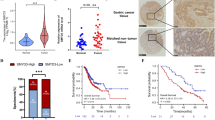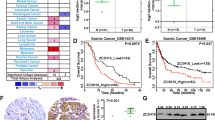Abstract
As one of the deadliest malignancies, gastric cancer (GC) is often accompanied by a low 5-year survival following initial diagnosis, which accounts for a substantial proportion of cancer-related deaths each year worldwide. Altered epigenetic modifications of cancer oncogenes and tumor suppressor genes emerge as novel mechanisms have been implicated the pathogenesis of GC. In the current study, we aim to elucidate whether histone deacetylase 3 (HDAC3) exerts oncogenic role in GC, and investigate the possible mechanism. Initially, we collected 64 paired cancerous and noncancerous tissues surgically resected from GC patients. Positive expression of HDAC3, FTO, and MYC in the tissues was measured using Immunohistochemistry. Meanwhile, GC cell line BGC-823/AGS was selected and treated with lentivirus vectors for alteration of HDAC3, FTO, or FOXA2 expressions, followed by detection on mRNA and protein levels of HDAC3, FOXA2, FTO, and MYC using reverse transcription quantitative polymerase chain reaction (RT-qPCR) and western blot assays. The results demonstrated that the expressions of HDAC3, FTO and MYC were upregulated, while FOXA2 expression was downregulated in GC tissues and cells. After that, the cell viability, migration, and invasion of GC cells were assessed by CCK-8 and Transwell assays, revealing that HDAC3 accelerated GC cell viability, migration and invasion by degrading FOXA2. Subsequently, the binding relationship among HDAC3, FOXA2, FTO, and MYC was assessed by assays of immunoprecipitation, dual-luciferase reporter gene, and chromatin immunoprecipitation assay. Methylation of m6A mRNA in GC cells was detected via gene-specific m6A qPCR and dot-blot assays. The transcription factor FOXA2 was found to bind to the FTO gene promoter and decreased its expression, while FTO stabilized MYC mRNA by reducing m6A methylation of MYC in GC cells. In addition, HDAC3 was observed to maintain the FTO/m6A/MYC signaling and regulated GC progression, which was also supported by in vivo animal study data of GC cell tumorigenesis in nude mice. These key observations uncover the tumor-initiating activities of HDAC3 in GC through its regulation on FOXA2-mediated FTO/m6A/MYC axis, highlighting the potential of therapeutically targeting epigenetic modifications to combat GC.
This is a preview of subscription content, access via your institution
Access options
Subscribe to this journal
Receive 12 print issues and online access
$259.00 per year
only $21.58 per issue
Buy this article
- Purchase on Springer Link
- Instant access to full article PDF
Prices may be subject to local taxes which are calculated during checkout









Similar content being viewed by others
References
Guggenheim DE, Shah MA. Gastric cancer epidemiology and risk factors. J Surg Oncol. 2013;107:230–6.
Fuccio L, Eusebi LH, Bazzoli F. Gastric cancer, Helicobacter pylori infection and other risk factors. World J Gastrointest Oncol. 2010;2:342–7.
Ngeow J, Tan IB, Choo SP. Targeted therapies in the treatment of gastric cancer. Asia Pac J Clin Oncol. 2011;7:224–35.
Jin Z, Jiang W, Jiao F, Guo Z, Hu H, Wang L, et al. Decreased expression of histone deacetylase 10 predicts poor prognosis of gastric cancer patients. Int J Clin Exp Pathol. 2014;7:5872–9.
Ma Y, Yue Y, Pan M, Sun J, Chu J, Lin X, et al. Histone deacetylase 3 inhibits new tumor suppressor gene DTWD1 in gastric cancer. Am J Cancer Res. 2015;5:663–73.
Bochkis IM, Przybylski D, Chen J, Regev A. Changes in nucleosome occupancy associated with metabolic alterations in aged mammalian liver. Cell Rep. 2014;9:996–1006.
Jang SM, An JH, Kim CH, Kim JW, Choi KH. Transcription factor FOXA2-centered transcriptional regulation network in non-small cell lung cancer. Biochem Biophys Res Commun. 2015;463:961–7.
Zhu CP, Wang J, Shi B, Hu PF, Ning BF, Zhang Q, et al. The transcription factor FOXA2 suppresses gastric tumorigenesis in vitro and in vivo. Dig Dis Sci. 2015;60:109–17.
Guo J, Ren W, Ding Y, Li A, Jia L, Su D, et al. Fat mass and obesity associated gene (FTO) expression is regulated negatively by the transcription factor Foxa2. PLoS ONE. 2012;7:e51082.
Li Z, Weng H, Su R, Weng X, Zuo Z, Li C, et al. FTO plays an oncogenic role in acute myeloid leukemia as a N(6)-methyladenosine RNA demethylase. Cancer Cell. 2017;31:127–41.
Xu D, Shao W, Jiang Y, Wang X, Liu Y, Liu X. FTO expression is associated with the occurrence of gastric cancer and prognosis. Oncol Rep. 2017;38:2285–92.
Su R, Dong L, Li C, Nachtergaele S, Wunderlich M, Qing Y, et al. R-2HG exhibits anti-tumor activity by targeting FTO/m(6)A/MYC/CEBPA signaling. Cell. 2018;172:90–105.
de Souza CR, Leal MF, Calcagno DQ, Costa Sozinho EK, Borges Bdo N, Montenegro RC, et al. MYC deregulation in gastric cancer and its clinicopathological implications. PLoS ONE. 2013;8:e64420.
Lam KW, Lo SC. Discovery of diagnostic serum biomarkers of gastric cancer using proteomics. Proteom Clin Appl. 2008;2:219–28.
Shah MA, Kelsen DP. Gastric cancer: a primer on the epidemiology and biology of the disease and an overview of the medical management of advanced disease. J Natl Compr Canc Netw. 2010;8:437–47.
Schizas D, Mastoraki A, Naar L, Tsilimigras DI, Katsaros I, Fragkiadaki V, et al. Histone Deacetylases (HDACs) in gastric cancer: an update of their emerging prognostic and therapeutic role. Curr Med Chem. 2019.
Xu G, Zhu H, Zhang M, Xu J. Histone deacetylase 3 is associated with gastric cancer cell growth via the miR-454-mediated targeting of CHD5. Int J Mol Med. 2018;41:155–63.
Deng R, Zhang P, Liu W, Zeng X, Ma X, Shi L, et al. HDAC is indispensable for IFN-gamma-induced B7-H1 expression in gastric cancer. Clin Epigenetics. 2018;10:153.
Li C, Lu S, Shi Y. MicroRNA-187 promotes growth and metastasis of gastric cancer by inhibiting FOXA2. Oncol Rep. 2017;37:1747–55.
Ba M, Long H, Yan Z, Wang S, Wu Y, Tu Y, et al. BRD4 promotes gastric cancer progression through the transcriptional and epigenetic regulation of c-MYC. J Cell Biochem. 2018;119:973–82.
Deng X, Su R, Weng H, Huang H, Li Z, Chen J. RNA N(6)-methyladenosine modification in cancers: current status and perspectives. Cell Res. 2018;28:507–17.
Zhang L, Hou Y, Ashktorab H, Gao L, Xu Y, Wu K, et al. The impact of C-MYC gene expression on gastric cancer cell. Mol Cell Biochem. 2010;344:125–35.
Zhang X, Chen X, Lin J, Lwin T, Wright G, Moscinski LC, et al. Myc represses miR-15a/miR-16-1 expression through recruitment of HDAC3 in mantle cell and other non-Hodgkin B-cell lymphomas. Oncogene. 2012;31:3002–8.
Zhang X, Zhao X, Fiskus W, Lin J, Lwin T, Rao R, et al. Coordinated silencing of MYC-mediated miR-29 by HDAC3 and EZH2 as a therapeutic target of histone modification in aggressive B-Cell lymphomas. Cancer Cell. 2012;22:506–23.
Chen JP, Lin C, Xu CP, Zhang XY, Fu M, Deng YP, et al. Molecular therapy with recombinant antisense c-myc adenovirus for human gastric carcinoma cells in vitro and in vivo. J Gastroenterol Hepatol. 2001;16:22–28.
Wang X, Li Z, Kong B, Song C, Cong J, Hou J, et al. Reduced m(6)A mRNA methylation is correlated with the progression of human cervical cancer. Oncotarget. 2017;8:98918–30.
Acknowledgements
We acknowledge anyone who contributed toward the article who does not meet the criteria for authorship including anyone who provided professional writing services or materials.
Funding
This work was supported by the National Natural Science Foundation of China (No. 81672877; No. 81502073).
Author information
Authors and Affiliations
Corresponding authors
Ethics declarations
Conflict of interest
The authors declare that they have no conflict of interest.
Additional information
Publisher’s note Springer Nature remains neutral with regard to jurisdictional claims in published maps and institutional affiliations.
Rights and permissions
About this article
Cite this article
Yang, Z., Jiang, X., Zhang, Z. et al. HDAC3-dependent transcriptional repression of FOXA2 regulates FTO/m6A/MYC signaling to contribute to the development of gastric cancer. Cancer Gene Ther 28, 141–155 (2021). https://doi.org/10.1038/s41417-020-0193-8
Received:
Revised:
Accepted:
Published:
Issue Date:
DOI: https://doi.org/10.1038/s41417-020-0193-8
This article is cited by
-
FOXA1 and FOXA2: the regulatory mechanisms and therapeutic implications in cancer
Cell Death Discovery (2024)
-
SHMT2 regulates esophageal cancer cell progression and immune Escape by mediating m6A modification of c-myc
Cell & Bioscience (2023)
-
LncRNA FTO-IT1 promotes glycolysis and progression of hepatocellular carcinoma through modulating FTO-mediated N6-methyladenosine modification on GLUT1 and PKM2
Journal of Experimental & Clinical Cancer Research (2023)
-
Role of N6-methyladenosine RNA modification in gastric cancer
Cell Death Discovery (2023)
-
FTO-mediated m6A modification promotes malignant transformation of gastric mucosal epithelial cells in chronic Cag A+ Helicobacter pylori infection
Journal of Cancer Research and Clinical Oncology (2023)



